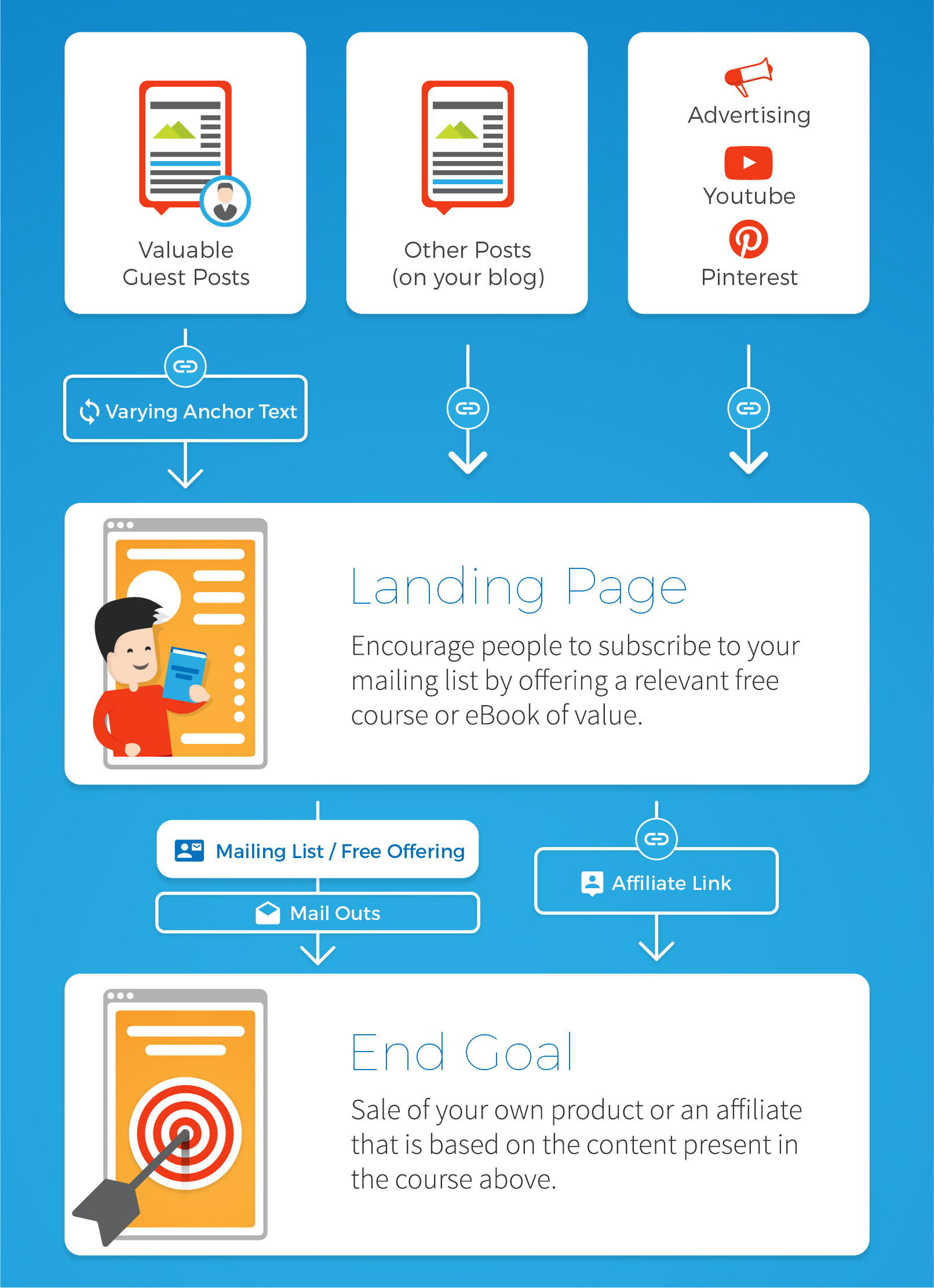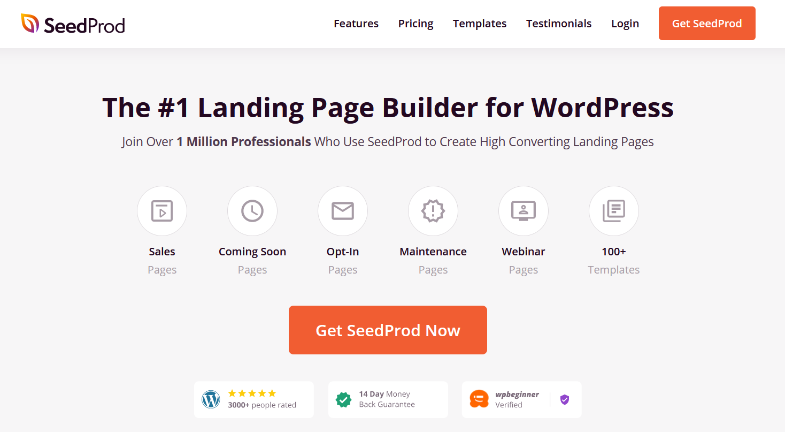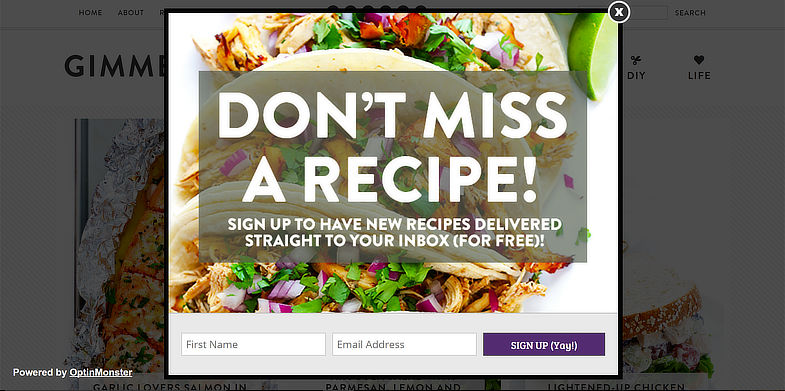
T oday I want to give you a few ideas on how to develop a blog strategy that you can use in any niche.
A quality blog strategy is what will help take your site to the next level.
Quite frankly, competition and Google updates make what we do increasingly difficult, and there is no point in starting a blog if you don’t have a solid blog marketing strategy to promote it.
Most people’s content plan is to post, tweet, and promote blindly – throwing a bunch of things at the wall to see what sticks. But, by making a few targeted changes, you can grow your blog in big ways much more quickly than you thought.
NOTE: This step-by-step guide to help you with creating blog content strategy assumes that you are on a self-hosted blogging setup with control of the backend, have a mailing list, etc.
In This Guide:
- A Quick Summary of This Blog Strategy
- Key Takeaways
- The Proven Blogging Strategy That Works in Any Niche
- 1. Always Start With an End Goal and Work Backward
- 2. Create a Landing Page to Match Your Target Audience
- 3. Research to Find That Super-Targeted Traffic
- 4. Guest Post To Promote Your Blog
- 5. Break Down Your Mailing List Offering
- Do You Really Need to Create a Blog Content Strategy?
A Quick Summary of This Blog Strategy With Key Takeaways
So, how do you get started with this particular blogging strategy?
Here’s a visual representation that might help you understand how it all fits together.

Ultimately, this free blog strategy will turn your blog into a hyper-optimized conversion machine.
Your posts and traffic will all be deliberately targeted towards that mailing list offering, which is the perfect introduction to your future product or service.
Key Takeaways For Your Blog Strategy
Remember this strategy is meant to be timeless. Meaning if you follow it you’ll be able to make money online regardless of Google updates, etc.
- Set Clear Goals: Begin with a clear end goal for your blogging activities. This might include financial objectives like selling digital products or non-financial goals like brand building.
- Target Audience Alignment: Create a landing page that resonates with your target audience. This should be directly aligned with the ultimate goal or product of your blog.
- Research for Targeted Traffic: Conduct thorough research to attract super-targeted traffic. This involves identifying and targeting specific demographics that align closely with your blog’s content and goals.
- Leverage Guest Posting: Use guest posting to promote your blog and reach a wider audience. Building relationships with other bloggers and websites in your niche can help amplify your content and increase visibility.
- Optimize Your Mailing List: Develop a compelling mailing list offering that is directly related to your blog’s main objectives. Use this to build a community around your blog and consistently engage readers with your future content.
Now, let’s dive into serious detail about how to put it all together.
The Proven Blogging Strategy That Works in Any Niche

When you sit down to blog (either on your site or a guest spot), you want to make sure at least one thing occurs: you want every article to play a role.
It might be a short-term role or a long-term role that sees you gradually growing your email marketing list, Google rankings via SEO (search engine optimization), and eventual sales.
But you never want to spend hours researching and writing an article to get a quick short-lived burst of traffic to your website and nothing else.
It’s wasteful.
Hopefully, at the end of this post, you’ll have a starting point for blogging more cohesively and a strategy for taking it to the next level.
1. Always Start With an End Goal and Work Backward
The first thing I always like to do is carefully think about what it is that I want my visitors to do at each step along the way. Most importantly, you want to know exactly what the end result of your process will be.
So, what kind of goals am I talking about?
- Financial goals
Will they purchase an eBook, website membership, or some other product you have created or plan to create soon? - Non-financial goals
Or maybe you have a non-financial goal, like promoting a cause or building your reputation in a certain industry to further offline career options. It might be as simple as growing a mailing list of a particular type of reader that may be useful in the future.
For the purpose of this post, I’m going to use the example of a yoga blog.
Whenever you post a new article, collaborate, plan your editorial content calendar (mapping out your content for a week/month/quarter/year), or purchase some advertising space, you want to make sure it helps you achieve one of your yoga blog’s end goals.
If you’re just getting traffic for the sake of traffic, you’ll waste a lot of time.
Don’t think you must have the whole premium course, eBook, or program written and developed before starting blogging strategically. That would also be a mistake.
You just want to have a clear idea about the topic and the target audience because then you know who you are going after and who you’re trying to get on your mailing list.
2. Create a Landing Page to Match Your Target Audience

Once you have figured out your end product or goal (remember, it might not be ready for six months), content marketers should create a mailing list funnel that matches it closely.
Here’s how it works.
Let’s say you want to sell a course called How to Build a Successful Yoga School in 12 Months. The first thing to do is set up a mailing list that specifically caters to that one future course and attracts readers to that mailing list with a five-part free email series called something like 5 Secrets from the World’s Top Yoga Schools.
This will be your first product funnel on that mailing list, but you can, of course, add new content types over the years.
Make this a useful course that gets sent to email subscribers automatically once they sign up to your new mailing list.
Think of it as a free gift to thank them for subscribing.
You’d then create a landing page that explains your free, five-part course.
You can create a blog landing page using SeedProd, WordPress’s #1 landing page builder.

Building landing pages is super easy with SeedProd’s drag-and-drop builder. Simply drag landing page elements like contact forms, email opt-in forms, countdown timers, videos, and more onto your page.
SeedProd even offers a wide selection of pre-made templates, so you can quickly create content on a beautiful landing page or content hub for your course.
Here’s an example of one:

Your landing page should:
- Focus on the benefits
Don’t just explain the features of the email series. Tell them what they will get out of it. - Explain the procedure
Make sure you explain how the mailing list thing works. You don’t want anyone to subscribe and then get surprised at all your emails and mark them as spam. - Have some social proof
Go ahead and put some testimonials and endorsements up on your landing page so that potential subscribers know it’s legitimate. If you don’t have any of these, look through your comments or social media pages and ask a regular reader/friend to write an honest one for you. - Be easily discoverable
Make sure you link to your landing page in a relevant and highly visible place on your blog. Consider making a graphic and adding it to your blog using a Scroll Triggered Box that slides out and draws attention, and an exit-intent popup to capture visitors who would otherwise leave forever.

In the end, you will have created a simple mailing list offering and landing page combo that attracts the exact type of people who might be interested in buying your course when you finally release it.
The next step is to find that traffic.
3. Research to Find That Super-Targeted Traffic

So, you’ve matched your mailing list offer to your future product.
Now, you need to match your traffic sources to your mailing list.
This is the most important step and, in my opinion, the one most bloggers don’t understand.
All traffic is different. Even people who might be highly interested in yoga (to follow our example) might be completely uninterested in starting a school. So you have to be very careful about the type of visitor that you go after.
It’s not enough to just consider the sources of traffic – organic search rankings, referrals from other blogs, forums, paid advertising, etc. – you also need to carefully consider the individual people that will be coming through from those places.
How, then, do we find the right people?
- Analyze and use the “close” competition
The first step I usually take is to look at the competition in that niche. First, you want to see what your competitors do that has been successful. Use SEO tools like SEMrush or Ahrefs to check the analytics of what websites are linking to them and do a bit of a content audit. Second, you want to find out if they accept guest posts or hire writers, which you can usually discover by reading their About or Contact pages. Make a list of all the closely matched websites in that niche. - Analyze and use the “far” competition
Once you’ve looked at the close opportunities, you want to start looking for the stuff that no one has thought about. For example, if you want to grow a list around the yoga school example, you might start looking for less obvious places that your target traffic might be hanging out, like bodybuilding forums, physiotherbapy practices with blogs, personal blogs of influencers, news sites, etc. These are the types of places where you can often get a guest post on a less direct topic and still drive backlinks and organic traffic. More on this later.
When you first start a blog and build out your content strategy, there is very little need for Twitter and Facebook posts. This type of content simply lacks reach unless you have an existing audience or are spending money.
Sure, be on them, but don’t spend hours and hours posting there.
4. Guest Post To Promote Your Blog

Once you’ve researched your target sites, it’s important to start landing some big guest post spots promoting the important landing pages and mailing list we built earlier.
But as many bloggers know, getting a guest post can be hard unless you’re already well-known in the industry.
So what do you do?
You build strategic connections.
After all, success comes from other people.
As you build your content and create your blog content – you need people “above” you in your network. They are the ones who will give you guest posting opportunities, mentions, and support when you have new content ideas or problems or pain points to solve.
You need people “below” you who share your content and quality blog posts with their networks to promote your blog, comment on your articles, and subscribe to your mailing list.
Now, I don’t mean this to sound degrading (no one is more important than anyone else). Remember – it’s just a helpful device you can use to promote your blog.
Here’s what I mean:
- Alliances above you
This includes all the people who are more experienced than you, people with big audiences, popular blogs, or bigger networks that can be useful to you. They are “above” me because they’re role models I look up to! This would usually be a marketer with a personal blog or blog sites that have been around your niche much longer than you. - Alliances below you
These are all the up-and-coming people who engage with your written content like subscribers, readers, and even other upcoming blog owners in your niche who produce quality content but are still looking to grow and expand.
Connecting with both types is extremely important to help put your blog on the map.
The most effective way I’ve found to get on the radar of big bloggers with my content marketing efforts is to mention them in your guest posts. Sure, giving them a shout-out on your blog is nice, but if you take the extra step and mention them on someone else’s big, great blog with more readers, you’ll instantly get brownie points.
Once you have built up a relationship with the right bloggers, it’s a good idea to try to land some guest posting spots. Once you do that, make sure you personally talk to everyone who shares, comments on or mentions your article.
Build those other connections!
Remember, these guest posts all have specific purposes and form part of our content marketing strategy.
Every guest post that you do should achieve the following business goals:
- Provide a long-term source of traffic
If you get the right spots, their sites will likely have better Google rankings and other search engine results than yours. This is good. Perform keyword research and write brilliant, long-form articles that rank for years and send you constant streams of traffic. - Pre-sell your landing page
Pre-selling is where you generate interest in something a reader/client hasn’t seen yet. For this content strategy for your blog, you want your in-depth content to pre-sell your mailing list by making people super-curious about the topic you’re covering or the problem you’re solving. When they click through to your blog from your guest post, they should be instantly attracted to your mailing list offering. - Build relationships
The last thing you want to make sure that you do is consolidate your relationship with the site owner. Find a way to make an impact in a distinctive way that makes you stand out from other guest bloggers. This might mean going a little further than normal and developing graphics, videos, slides, etc. The best outcome here is that your guest post ranks so well on Google that it sends them (and you!) traffic for years.
So, how do you develop something that meets all of these criteria?
Simple.
5. Break Down Your Mailing List Offering
Let me explain.
Let’s go back to the hypothetical yoga school mailing list offering 5 Secrets from the World’s Top Yoga Schools. A tactical guest post in this niche would be on a BuzzFeed-style site called something like 21 Photos Inside the Yoga Schools of the Celebrities. You’ve taken a topic directly related to your mailing list offering and turned it into good content marketing plan of its own accord.
Done correctly, this type of guest post gets a lot of shares on Facebook and also attracts your target audience because yoga school teachers will have their students, family, and friends tagging them in the post to show them these fancy school buildings.
A second example of a tactical guest post would be on a popular business website or business section of a news website.
An article like How Maria Built a $1m a Year Yoga School in a Recession would provide an opportunity for great content in the form of a long-form article and a lot of interest from your target audience and other bloggers who might link to interesting case studies.
Basically – you want to take your mailing list offering or end product and break it down into smaller subtopics. I’ve found this to be an extremely useful way to ensure your guest posts continue to work for you over a long period of time while making them highly relevant to all the stuff you will be doing in the future.
Do You Really Need to Create a Blog Content Strategy?
I wanted to add this in just in case you’re still not convinced!
Over the years, I have noticed a gap between the ideas people have for new blogs and the actions they take to make them happen.
The blogs that succeed almost always:
- Have short and long-term goals
There is a very deliberate idea of what they want to achieve after a defined period of time. Long term goals like executing a successful content strategy takes time. - Have a specific strategy in mind
They don’t just post and hope. The best blogs know what will happen at every stage of the process. - Spend money
Can you imagine starting a shop without spending money on advertising, fit-out, and stock? The best blogs know that, often, you need to spend some money to make it work (or at least speed things up). - Have well-thought-out brands
Ever noticed that the best blogs just “seem” different? That’s deliberate branding. They’ve thought about their point of difference and how to stand out from the crowd.
So yes, you need a blog content strategy if you want to give your blog a chance.
Now, I know that not every blogger wants to make money from their blog.
But that doesn’t mean you don’t want it to be successful.
Running a successful blog means building brand awareness. To succeed, you need to think like a business that can adapt to new digital marketing trends and realities.
You need to potentially help many more people, opening new doors to exciting opportunities and reaching new readers who might impact your career and life in big ways.
I wouldn’t want to spend all those hours writing and working on my blog unless I knew I would do something meaningful with it.
Ready To Take Action On Your Blog Strategy?
I know many bloggers struggle to find a successful blog strategy to take their sites to the next level. It’s heartbreaking to hear about all the hours, weeks, and even years of work that people put in seemingly valuable content creation and still don’t see results.
Also, check out our guide on the best blogging platforms.
I’d be really interested to know whether you have a strategy for your new blog and how it’s working. And if you’re ready to create a successful blog, will you try out these tips and best practices?
Please leave a comment and let us know.


Great Post, Really Helpful for Beginners Like me
Glad you found it useful, Raghuram!
Email Marketing is also one of the most profound and useful techniques to achieve business goal-hence is a fundamental part of digital marketing. Hence, this blog enables us to get to the point of email marketing so to enhance marketing capabilities. I really loved it.
Hey, thank you man for this useful content. As i am planning to start blogging.
I liked your visual way of explaining.
Great work man
Thanks Akash, glad you liked it! When you’re ready to start your blog, check out our step-by-step guide: https://www.blogtyrant.com/start-a-new-blog/
Hey This is really Nice Blog for blogging. Thank you for sharing this blog with us.
Great post. I like the idea of mentioning big names on guest posts. I had a client who would request me to mention and highlight the works of his selected big names.
I was so surprised when he told me to write him a long guest post for one of his dream bloggers. (Am now planning on applying this for my writing services website)
This is a very powerful strategy.
After every successful guest post, he used to notify all the people we mentioned in the guest post.
After Writing 15 posts, we managed to connect with 3 powerful big names in his niche. It’s not so hard to achieve. Try it. You won’t be disappointed. This was all achieved within 3 months. Keep praising their work, they’ll notice you and pay back.
I don’t have a strategy and have been struggling to come up with one. This is a great start for me since it breaks everything down into actionable steps. Many people only talk generally about blogging. Thanks so much for the help!
Awesome post, you made it really easy to understand this pretty hard topic for beginners. You helped me a lot so I just wanna say thank you.
Thank you for taking the time to write this post. There are some great ideas in there.
I think we sometimes try to write for the search engines only and forget that it is humans who will be reading our posts!
Absolutely. It’s easy for your readers to tell when you’re not writing for them.
Useful tips, thanks for sharing!
This is very helpful for developing a blog or website. Thanks for sharing this type of post.
Keep Sharing
This is the kind of thorough guide I’ve been looking for! It gives me a clear idea of where I should go in order to take my blog to the next level. I’ve been following some of these tactics for a while, but not all of them. I’ll make sure to include them in my blogging plan. Thanks for sharing.
Good luck, Zola! When you get started writing, you might find our checklist helpful: https://www.blogtyrant.com/101-blogging-tips/
I love all the information. Its concise. Its packed with need to know step by step info and resources or tools and above all else its great for someone like myself, a newbie.
Your blog is amazing, keep posting more and share with the world.
Thanks for the huge tips. I am a blogger and the strategies you’ve outlined above are exactly what’s needed to succeed as a blogger. I know this because it’s what successful bloggers say and honestly, I feel I need to keep on implementing these tips. Thanks for your time in coming up with the great info.